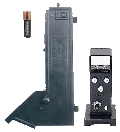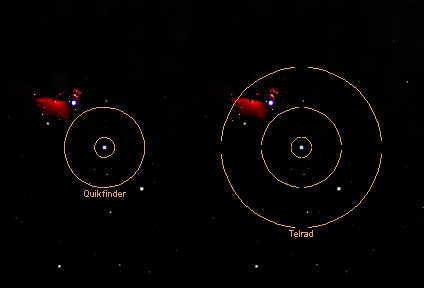Telrad vs
Quikfinder
Date:
01/01/2006
We have both the Telrads and the Rigel
Quikfinders in stock.

The Telrads are bigger and bulkier, so from an
aesthetics point of view, they may look overly large on a small telescope. The
Quikfinders though stick up perpendicular to the telescope axis, and so too
detract from any sleek looks your streamlined telescope may have. The image on
the right shows the relative sizes of the two finders side by side with a
standard AA battery for reference.
The design of the optics in the Telrads are
superior to the Rigels. The bullseye ring is truly projected at infinity so that
no matter how much you head is bobbing up and down as you sight through the
finder, the bullseye stays fixed in the sky. Not so for the Rigels - they do
seem to move around if you move your head left and right, except when you have
your eye literally up close to the finder, which is somewhat difficult to use.
Both finders allow you to adjust the brightness
of the reticles, but the Rigels have the ability to blink the reticle built in.
If you desire this feature in the Telrads, you'll need to buy a separate kit
that you'll have to install yourself. Blinking is useful when you're trying to
aim at very faint stars as the light from the reticle may wash them out. This is
certainly a personal preference, but many people are perfectly happy without the
blinking, and can simply dial up and down the brightness in order to spot the
faint stars.
Both of them do support the ability to be moved from one base to another. If you
will be doing this often, then you will need to have an additional base so that
you can move the finder from one telescope to the other. The Rigel comes with an
additional baseplate included, but you'll need to buy one for the Telrad.
Battery life is also a factor. The RIgel uses lithium button cells, whereas the
Telrad uses regular AA batteries. If you've used these finders before, it is a
relatively common occurrence to accidentally leave them on when you pack up for
the night. The Rigel drains its batteries quicker and costs more to replace the
batteries. There have been lots of stories of Telrads having been left on after
an ob session, and even after a month or more after being in the closet, they
are still operating !! And AA batteries are easy and inexpensive to obtain.

The shape of the reticles is another factor too. The Rigel has two concentric
rings at 1/2 and 2 degrees. The Telrad has 3 rings at 1/2, 2, and 4 degrees. The
image at the right shows both reticles aiming at Alnilam, the centre star of
Orion's belt. More importantly though, the Telrad rings are divided into
quadrants so if the Telrad is mounted well, the gaps in the rings correspond to
an axis of your mount. When trying to accurately aim your telescope either with
electronic controllers or with slow motion controls, these gaps are a real aid
in helping you to know which axis to move in order to center your target. They
function very similar in concept to the guiding reticles that have a cross-hair
which is aligned to the axis of your mount.
One point worth noting is that even though you have a single power finder, you'd
probably still want to have your regular powered finder (e.g. I use both the
Telrad AND a 9x50 finder). This is true especially in Singapore, where you have
light-polluted skies, and also when you are using higher powered scopes or
magnifications. If you only have a few stars visible to the naked eye, you'd
probably still need to use the powered finder to see more stars to help get to
the right target.
Bottom line, if price and aesthetics are important to you, then the Rigel
Quikfinder is probably the better choice. If you value performance and prefer
lower long term running costs, the Telrad is better. Personally, I prefer the
Telrad because of the true projection of the bullseye to infinity.
The prices for both the Telrad and Rigel are fairly close to each other. Ultimately though, it's a
personal preference with many satisfied customers from both camps.
Hope this helps !!
Joo Beng |

